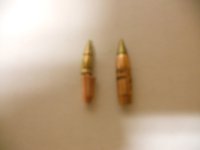Glock19Fan
New member
A single round fired from a Colt 14.5 1:7 at a distance of 15 meters into jugs of water. Bullet likely yawed and fragmented, with two major peices progressing the channel. The base penetrated 20 inches of water, and was recovered in clothing that was placed behind the jugs. The nose (steel) was recovered after 14 inches of penetration.
The bullet construction is simple- A steel nose, a solid copper base, and a copper (?) jacket that holds them together. Being two separate peices allows the bullet to break apart easier, relying only on the failure of the jacket rather then the jacket and lead core with normal ball rounds. The jacket wasnt recovered, however, I do think that it sustained decent fragmentation.
Not very scientific but at least it gives us an idea of what the round can do. I personally think the standard green tipped M855 would be more effective against two legged attacks, but I do think that the advantage the A1 has in penetration, along with the consistancy, makes it an all around great round for the battlefield.
The bullet construction is simple- A steel nose, a solid copper base, and a copper (?) jacket that holds them together. Being two separate peices allows the bullet to break apart easier, relying only on the failure of the jacket rather then the jacket and lead core with normal ball rounds. The jacket wasnt recovered, however, I do think that it sustained decent fragmentation.
Not very scientific but at least it gives us an idea of what the round can do. I personally think the standard green tipped M855 would be more effective against two legged attacks, but I do think that the advantage the A1 has in penetration, along with the consistancy, makes it an all around great round for the battlefield.

